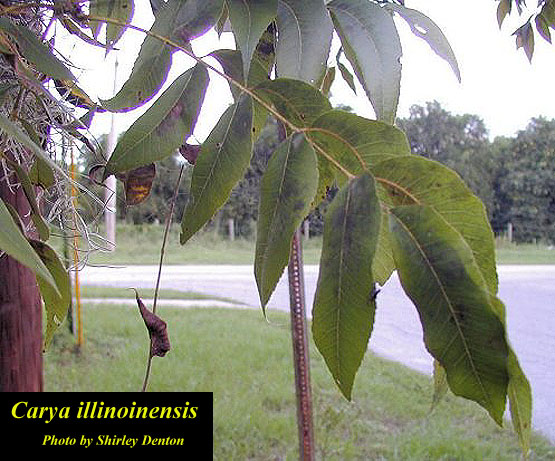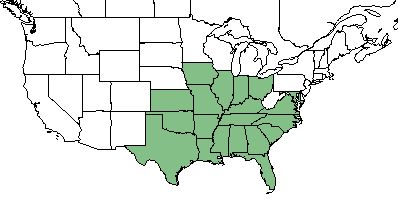Carya illinoinensis
Common name: Pecan [1]
| Carya illinoinensis | |
|---|---|

| |
| Photo by the Atlas of Florida Plants Database | |
| Scientific classification | |
| Kingdom: | Plantae |
| Division: | Magnoliophyta - Flowering plants |
| Class: | Magnoliopsida - Dicots |
| Order: | Juglandales |
| Family: | Juglandaceae |
| Genus: | Carya |
| Species: | C. illinoinensis |
| Binomial name | |
| Carya illinoinensis Wangen. | |

| |
| Natural range of Carya illinoinensis from USDA NRCS Plants Database. | |
Contents
Taxonomic Notes
Synonyms: Carya illinoensis; Hicoria pecan (Marshall) Britton; Hicoria texana LeConte
Varieties: none
Description
C. illinoinensis is a perennial tree of the Juglandaceae family native to North America.[1] Reaching heights between 100-140 feet, pecan is a medium to large deciduous tree. Leaves alternate and pinnately compound, and 11-17 leaflets that have a length between 4-8 inches. Unisexual flowers, which are located in separate clusters on the same tree. Fruit is a thin-shelled nut located in clusters of 3-12, four winged from the base to the apex, and brown in color with yellow scales. Husk is thin and can persist on branches into winter, while the nut is thin-shelled, reddish-brown, and pointed on each side. Bark can be light or grayish brown, and is shallowly furrowed and flat ridged.[2]
Distribution
C. illinoinensis can be found in the southeastern corner of the United States. [1] It was originally native to the south-central U.S., but is now more widespread into the southeastern region due to cultivation. [3]
Ecology
Habitat
C. illinoinensis is found in bottomlands, suburban woodlands, rural forest edges and floodplains, and is commonly cultivated around dwellings and in orchards.[3][4] It grows on moist and rich soils that are well-drained, and soils that are not subjected to continued flooding.[2]
Fire ecology
C. illinoinensis is not fire resistant, and has a low fire tolerance. [1]
Use by animals
C. illinoinensis is not highly palatable to grazing or browsing animals, but is highly palatable to humans.[1] The tree produces edible nuts for humans, and oil extracted from the nuts is used for cosmetics and cooking. Milk can also be extracted from the nut for various uses, and the wood is used occasionally for furniture, flooring, paneling, and cabinetry. Historically, Native American tribes used C. illinoinensis for multiple medical ailments. The Comanche tribe used pecan as a treatment for ringworm by pulverizing the leaves and rubbing this on the effected area. The Kiowa tribe created a decoction to consume for treatment of tuberculosis from the bark of the tree. For wildlife, C. illinoinensis is used quite extensively. White-tailed deer browse on seedling and older trees' lower branches, nuts are eaten by various birds, raccoons, opossums, and squirrels, and the tree as a whole provides cover for various mammals and birds.[2]
Conservation and Management
Cultivation and restoration
C. illinoinensis is a highly cultivated plant due to its use by humans as food. [3]
Photo Gallery
References and notes
- ↑ 1.0 1.1 1.2 1.3 1.4 USDA Plant Database https://plants.usda.gov/core/profile?symbol=CAIL2
- ↑ 2.0 2.1 2.2 Moore, L. M. (2006). Plant Guide: Pecan Carya illinoinensis. N.R.C.S. United States Department of Agriculture. Baton Rouge, LA.
- ↑ 3.0 3.1 3.2 Weakley, A. S. (2015). Flora of the Southern and Mid-Atlantic States. Chapel Hill, NC, University of North Carolina Herbarium.
- ↑ URL: http://herbarium.bio.fsu.edu. Last accessed: June 2018. Collectors: Loran C. Anderson, R.K. Godfrey. States and counties: Franklin County Florida, Leon County Florida, Gadsden County Florida, Jefferson County Florida, Jackson County Florida, Liberty County Florida, Washington County Florida, Holmes County Florida, Madison County Florida.